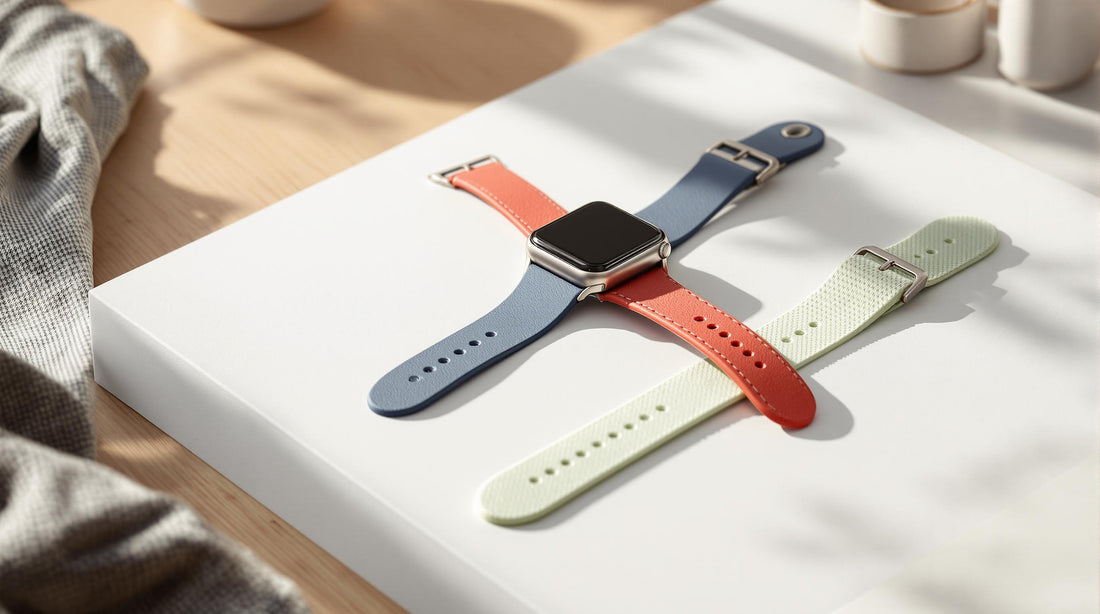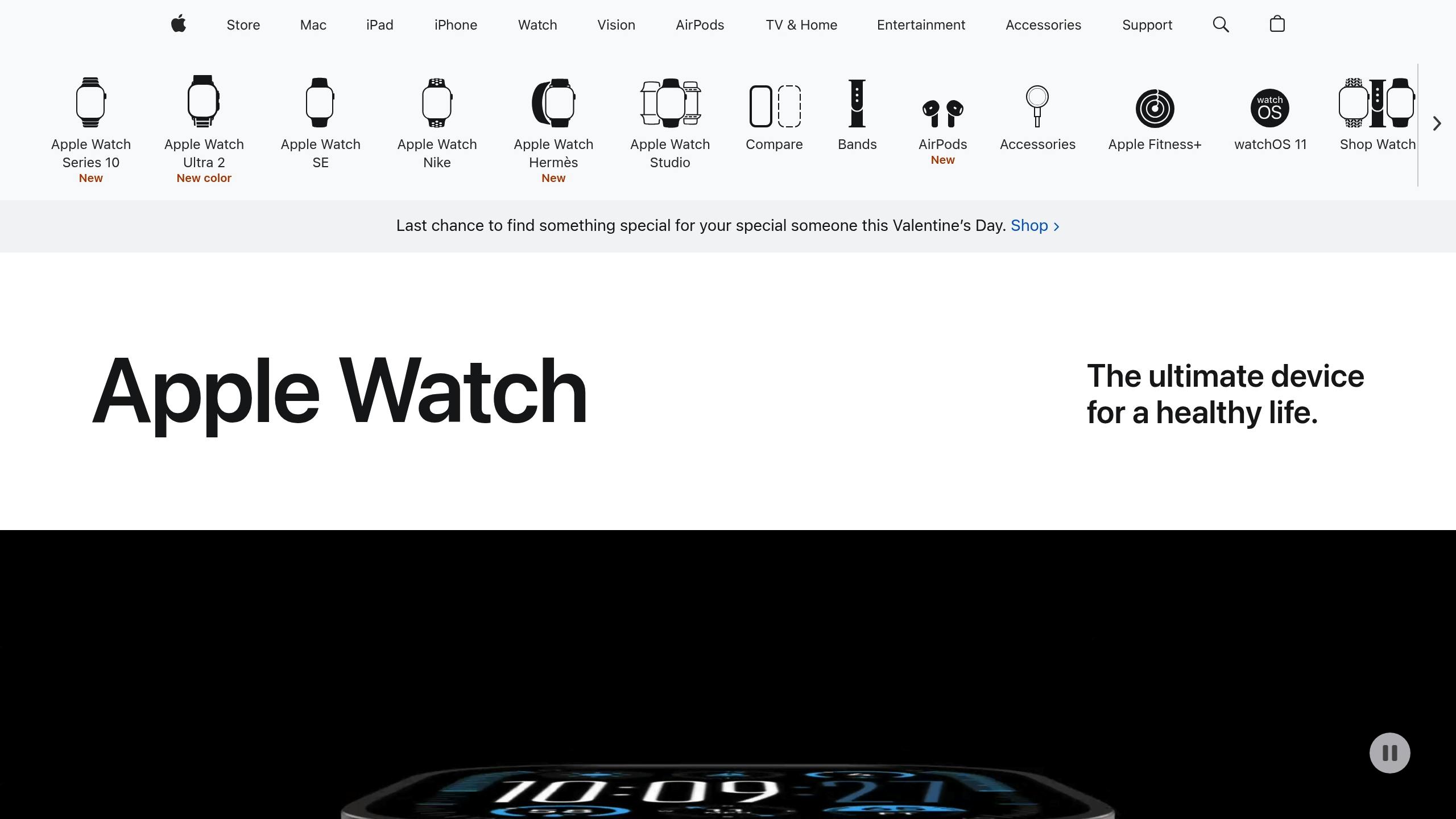Apple Watch Strap Care Checklist

Want to keep your Apple Watch strap clean, durable, and safe for daily use? Here's everything you need to know in one place. Proper care ensures your strap lasts longer, stays hygienic, and looks great. Follow these quick tips:
- Silicone/Rubber Straps: Clean with mild soap and water; avoid harsh chemicals.
- Leather Straps: Wipe weekly, clean monthly with leather cleaner, and condition every 3–6 months.
- Metal Straps: Use mild soap and polish for shine; avoid excess moisture.
- Nylon/Fabric Straps: Wash with mild detergent and air-dry for 12–24 hours.
Key Practices:
- Dry straps properly to avoid damage.
- Store in cool, dry places away from sunlight.
- Inspect for wear and replace straps when needed.
Why it Matters: Straps can harbor bacteria like Staph and E. coli. Regular cleaning improves hygiene, durability, and appearance. Ready to dive deeper? Let’s get started!
Before You Start: Setup Steps
How to Remove Your Watch Strap
Removing your Apple Watch strap the right way helps avoid any damage to the watch or the band. Here's how to do it:
- Place your watch face down on a soft, clean surface.
- Find the two small release buttons located on either side of where the band connects.
- Press and hold one of the release buttons.
- While holding the button, slide the band horizontally to remove it.
- Repeat the process for the other side.
Avoid these common mistakes:
- Forgetting to fully press the release buttons before sliding the band.
- Trying to remove the band at an angle rather than sliding it straight.
- Using sharp tools, which can scratch or damage your watch.
Required Cleaning Tools
Different band materials need specific cleaning tools to ensure proper care:
| Material | Tools |
|---|---|
| Silicone/Rubber | Microfiber cloth, mild soap, water, soft-bristled toothbrush |
| Leather | Leather cleaner, lint-free cloth |
| Metal | Metal polish, microfiber cloth |
| Nylon/Fabric | Soft brush, mild detergent, clean water |
For stubborn stains on silicone bands, Apple suggests using 70% isopropyl alcohol wipes or Clorox Disinfecting Wipes [5].
Creating Your Cleaning Space
Setting up a good workspace can help you clean your watch band safely and efficiently:
- Pick a clean, flat surface away from water to avoid scratches or accidental spills.
- Use shallow containers to limit liquid exposure to your watch or band.
- Set aside a dry area for placing cleaned parts.
- Gather all your cleaning tools and materials before you begin to stay organized.
Cleaning Steps by Strap Material
Cleaning Silicone and Rubber
For silicone or rubber straps, use a mild soap solution and a soft-bristled brush, especially on textured areas where dirt can accumulate. For tough stains, try a paste made from baking soda[1]. Regular cleaning helps keep bacteria at bay and ensures the strap stays hygienic.
Avoid these when cleaning silicone or rubber:
- Harsh chemicals like bleach or hydrogen peroxide
- Acetone-based cleaners
- Abrasive materials that could damage the surface
Once cleaned, follow the drying methods detailed in the next section to avoid moisture-related issues.
Cleaning Leather
For leather straps, wipe them weekly with a dry cloth to remove dust. Once a month, clean them with a leather cleaner, and every 3–6 months, apply a leather conditioner using a lint-free cloth[3]. Conditioning helps the strap stay flexible and in good shape for daily use.
Cleaning Metal and Magnetic Bands
Metal bands require gentle care to maintain their appearance and protect any magnetic components. Use a lint-free cloth dampened with warm water and mild soap. For polished finishes, a jewelry polishing cloth can bring back their shine[4].
Tips for magnetic closures:
- Stick to dry cloths when cleaning magnetic areas
- Avoid exposing magnets to excess moisture
- Skip ultrasonic cleaners, as they can interfere with magnetic properties
- Dry thoroughly with a soft cloth to prevent water spots or damage
Proper drying ensures the strap remains free from water damage, as noted in earlier sections.
Cleaning Nylon and Fabric
Nylon and fabric straps are prone to absorbing odors and stains. To clean, mix a solution of mild detergent and warm water[6]. For FineWoven bands, use 1 teaspoon of liquid detergent mixed with 1 cup of water. Let the strap air dry for at least 24 hours[5].
Ensuring the strap is completely dry helps maintain its durability and long-term usability.
After Cleaning: Next Steps
Drying and Storage Methods
Once you've cleaned your watch straps, drying them properly is just as important. Here's a quick guide based on the material:
| Material | Drying Method |
|---|---|
| Silicone/Rubber | Pat dry, then air dry for 30-60 minutes |
| Leather | Air dry for 24-48 hours; avoid using heat |
| Metal | Wipe dry immediately |
| Nylon/Fabric | Air dry for 12-24 hours |
When it comes to storage, keep your straps in a cool, dry area away from direct sunlight. For leather straps, breathable pouches are a great option - they help with air circulation while keeping dust at bay.
What Damages Watch Straps
Cleaning and drying are essential, but knowing what can harm your straps helps you protect them even better. Here are the main culprits:
- Excess moisture, particularly for leather straps, can lead to damage.
- Direct sunlight can weaken or fade certain materials over time.
- Chemicals from products like perfumes or lotions can degrade the strap.
- Improper storage or handling can cause unnecessary wear and tear.
- Dirt buildup from skipping regular cleaning can become harder to remove.
- Extreme temperatures may compromise the durability of some materials.
Leather straps, in particular, are sensitive to their surroundings. Avoid wearing them while cooking or handling strong chemicals [2]. For both leather and metal straps, consider using care products designed for these materials or seeking professional cleaning services when needed.
sbb-itb-f6ade85
How to Clean Apple Watch Bands - Complete Guide for All Types

Daily Use Tips
Simple daily habits can go a long way in keeping your Apple Watch strap in good shape. Combine these with the cleaning methods tailored to each material mentioned earlier.
Switching Straps for Different Activities
Changing straps based on your daily activities can help reduce wear and tear. Here’s a quick guide to choosing the right strap for different situations:
| Activity | Best Strap | Why It Works |
|---|---|---|
| Workouts/Swimming | Silicone/Sport Band | Water-resistant and easy to clean |
| Office/Formal Events | Leather/Metal | Polished look and comfortable fit |
| Outdoor Activities | Nylon/Sport Loop | Breathable and durable |
| Sleep Tracking | Soft Silicone/Nylon | Lightweight and comfortable |
Checking for Damage
A quick inspection can help you spot small issues before they turn into bigger problems. Here’s what to look for based on strap material:
- Silicone and Rubber Straps: Watch for discoloration, tears near connectors, or changes in texture.
- Metal Bands: Check for loose links, tarnishing, corrosion, or clasp issues.
- Leather Straps: Look for cracking, peeling at bend points, color changes, water damage, or stretched buckle holes.
- Nylon and Fabric Straps: Inspect for frayed edges, weakened weave patterns, or fading.
If you notice any damage, replace the strap promptly to maintain both its functionality and your watch’s overall look. For material-specific options, refer back to the cleaning methods section for recommendations. Regular replacements ensure your strap stays effective and stylish.
Maintaining Strap Hardware
Taking care of your strap's hardware is just as important as maintaining the strap material. Proper attention ensures your strap stays securely attached and functions well over time.
Checking Connection Points
Inspect the areas where your strap connects to the watch face at least once a month. Here's what to focus on:
| Area | What to Look For | What to Do |
|---|---|---|
| Metal Pins/Lugs | Loose or wobbly parts | Tighten or replace them |
| Connection Surface | Scratches or bending | Clean and check for damage |
| Release Button | Stiff or rough movement | Clean thoroughly |
| Surrounding Material | Fraying or visible wear | Keep an eye on it for replacement |
Cleaning Buckles and Clasps
Metal components like buckles and clasps need regular care to keep them working smoothly and looking good. Adjust your cleaning routine based on how often you wear the watch.
Quick Daily Care:
- Use a dry microfiber cloth to wipe away sweat or water after wearing.
Deep Cleaning Steps:
- Follow the cleaning process for metal bands (refer to the section on Cleaning Metal and Magnetic Bands).
- Use a small amount of WD-40 to loosen any stiff clasps.
If you spot corrosion or mechanical issues, it's better to replace the hardware than risk damaging your watch or losing it.
Conclusion: Quick Care Tips Summary
To keep your Apple Watch strap in great condition, pair the earlier cleaning tips with a regular care routine for cleaning and drying. This ensures your strap stays in shape for longer.
Here’s a quick care checklist:
- Silicone straps: Wipe down after workouts.
- Leather straps: Condition once a month.
- Metal straps: Polish weekly.
- Nylon straps: Let them air-dry overnight.
General care tips for all straps:
- Keep them away from heat and direct sunlight.
- Clean them right after sweating or swimming.
- Avoid exposure to harsh chemicals.
When it’s time for a replacement, check compatibility with your watch. Brands like Friday offer a range of straps in different materials to suit your needs.









